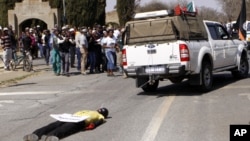JOHANESSBURG — While South Africa mourned the deaths of more than 30 striking miners last week, a black farmworker, Chris Mahlangu, was sentenced to life in prison Wednesday for the 2010 murder of white supremacist Eugene Terreblanche. In both cases, a culture of violence born in deep economic inequalities has been blamed.
The scene outside the court looked like the ghost of a shameful past. As Chris Mahlangu, Eugene Terreblanche's convicted killer, was being jailed for life, about 20 white supremacists carried a doll representing a black man with a rope around his neck and a sign that said "hang Mahlangu". On the opposite sidewalk, 100 demonstrators sang racially-charged songs in support of Mahlangu.
Mahlangu's trial ended as it began two years ago: in a heated atmosphere and amid accusations of a racist murder by the supporters of the white supremacist victim. But the judge concluded the motive was, first and foremost, a violent dispute over wages, that Mahlangu broke into his former employer's house at night, and beat him to death because he claimed Terreblanche owed him money.
An associate professor of social sciences at Wits University in Johannesburg, Devan Pillay, sees a link between this case and the Marikana mine massacre. "Just like the Lonmin Marikana massacre seems like a simple industrial relation dispute, it has huge symbolism for the whole country," he said.
Pillay says that both cases show extreme violence used as an answer to dysfunctional work relationships. To him, this is something specific to South Africa and is a legacy of colonialism and of white minority rule, known as apartheid.
"It put a spotlight on the extremely unequal relations between the employers and employees, which has characterized South Africa's industrial relation and social situation generally from colonial times through apartheid," Pillay explained. "And it persists today."
The deep inequalities trigger violence. South Africa has one of the highest homicide rates in the world, as well as one of the biggest gaps between rich and poor. Pillay says these gaps have been the center of South Africa's economy for a long time. "Our economic system is based on cheap labor and continues to be based on cheap labor. Both in the domestic sphere, in Terreblanche's case, but also in the mining industry which has been the bedrock of our economy," he added. "Of the apartheid economy and post apartheid economy."
Last July, South African President Jacob Zuma himself said that the structure of the Apartheid-era economy has remained largely intact. While the country's economy is booming, nearly half of South Africans still live below the poverty line.
The scene outside the court looked like the ghost of a shameful past. As Chris Mahlangu, Eugene Terreblanche's convicted killer, was being jailed for life, about 20 white supremacists carried a doll representing a black man with a rope around his neck and a sign that said "hang Mahlangu". On the opposite sidewalk, 100 demonstrators sang racially-charged songs in support of Mahlangu.
Mahlangu's trial ended as it began two years ago: in a heated atmosphere and amid accusations of a racist murder by the supporters of the white supremacist victim. But the judge concluded the motive was, first and foremost, a violent dispute over wages, that Mahlangu broke into his former employer's house at night, and beat him to death because he claimed Terreblanche owed him money.
An associate professor of social sciences at Wits University in Johannesburg, Devan Pillay, sees a link between this case and the Marikana mine massacre. "Just like the Lonmin Marikana massacre seems like a simple industrial relation dispute, it has huge symbolism for the whole country," he said.
Pillay says that both cases show extreme violence used as an answer to dysfunctional work relationships. To him, this is something specific to South Africa and is a legacy of colonialism and of white minority rule, known as apartheid.
"It put a spotlight on the extremely unequal relations between the employers and employees, which has characterized South Africa's industrial relation and social situation generally from colonial times through apartheid," Pillay explained. "And it persists today."
The deep inequalities trigger violence. South Africa has one of the highest homicide rates in the world, as well as one of the biggest gaps between rich and poor. Pillay says these gaps have been the center of South Africa's economy for a long time. "Our economic system is based on cheap labor and continues to be based on cheap labor. Both in the domestic sphere, in Terreblanche's case, but also in the mining industry which has been the bedrock of our economy," he added. "Of the apartheid economy and post apartheid economy."
Last July, South African President Jacob Zuma himself said that the structure of the Apartheid-era economy has remained largely intact. While the country's economy is booming, nearly half of South Africans still live below the poverty line.













